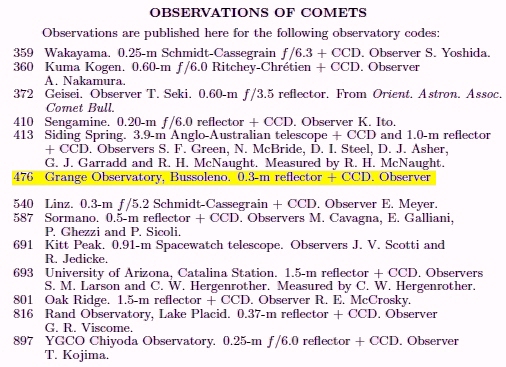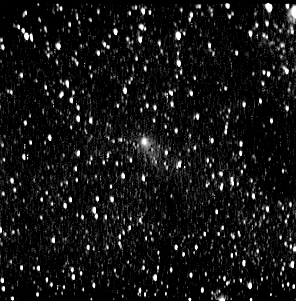TIPS ON ASTROMETRY
Astrometry
Everybody is reading this page (i.e. has got a PC connected to the Web) and owns a telescope with a CCD camera can virtually
start measuring the position of asteroids and comets, which is called astrometry: the more those measures are
accurate (less than one arcsec), the better the orbit of the celestial body is known, and this is very important for
asteroids and comets which approach the Earth's orbit or are targets of spacecrafts.
Astrometry indeed is one of the fields where amateur astronomers can collaborate with professionals at the same level, and
this is evident in the official reports known as Minor Planet Circulars prepared by MPC, where single amateurs and the
world most famous astronomical sites like E.S.O., Kitt Peak, Siding Spring, etc. publish their observations together
(see below...)

The same instruments used in astrometric routine work could be employed in asteroid hunting, possibly with robotic telescopes to increase the efficiency: the methodology is to
compare two images of the same part of the sky taken with, say, a 30 min. interval, and look for not-catalogued objects
which have meanwhile moved.
If the further observations allow to calculate the orbit with the sufficient
accuracy, the people who have discovered the new celestial body will have the
privilege to name it as they want.

Comet C/1998 M5 LINEAR has moved during half
an hour interval: the two images (stacked together and then animated) have been taken at Grange Observatory on the evening of Sep. 18th, 1998 with CCD SXL8, 60 s exposure each.
What's needed for the astrometric activity:
- the connection to the MPC (Minor Planet Center) is needed for accessing directly the major database on asteroids and comets;
- the astrometric program
can measure the CCD images and access the needed stellar catalogues on-line;
- an NTP server connection for the accurate
timing turns the PC erratic clock in an observatory reference time source;
- the photographic plates taken at Mount Palomar Obs. for the all-sky survey are retrievable at POSS site: the stellar limit magnitude is about 21.
Very useful to check if the CCD image just taken is the right one or not;
- the MPC "Guide for Minor-Body Astrometry" is on-line here;
- Excellent freeware softwares (Charon and Find_orb) useful for astrometry can be found in Project Pluto's site;
- See the speckle imaging tecniques.
Back to Grange Obs. homepage.


